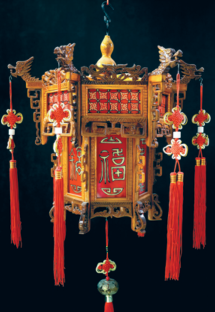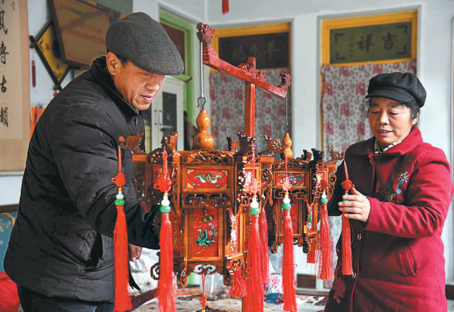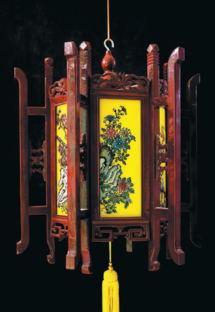In a new light
Dedicated craftsman makes palace lanterns, preserving tradition, report Wang Qian and Sun Ruisheng in Taiyuan.

Combining techniques with delicate designs, palace lanterns have long reflected aesthetics. The first kerosene-lit lamp in China appeared on a Shanghai street in 1843. However, the handicraft was under threat of vanishing.
In Feng Huailin's studio in Wangshouzhuang village, Yuncheng, Shanxi province, the 62-year-old lantern maker still works with traditional techniques, dating back to the Qing Dynasty (1644-1911), inherited through his family.
With its origins in the Eastern Han Dynasty (25-220), lantern-making reached its peak during the Qing Dynasty when palace lanterns became a common scene at the imperial court.
Consisting of nearly 300 wood components, a set of palace lanterns usually takes Feng and his wife Duan Jinju at least a month to make. Large sets take them up to three months.
"My childhood memories are connected to lanterns as both my father and grandfather made them," Feng says, adding that it has been a local tradition to gift a set of palace lanterns from grandparents to their newborn grandchildren as blessings for a bright future.
Although Feng is a talented carpenter and good at drawing, he didn't think about inheriting the family business until his son was born in 1987.
"The idea came to me that I wanted to make a lantern for my son," Feng says.
Based on the design drafts passed down generations, Feng and Duan followed his predecessors a century before them. From wood selection to assembling, it took the couple more than two months to finish their first palace lantern.
Feng still remembers how cold the night was when they forgot about time while making some lanterns, with their fingers and arms swollen after a long time of woodcarving work. Then for 10 years, Feng did various jobs, but when back home, the craft took up all his leisure time.
In 1997, he came across a story in a paper that local authorities were collecting folklore artworks. His set of palace lanterns were selected and won him 8,800 yuan ($1,279). It was the first time that his hobby earned him money.
Seeing the business potential, Feng quit his job and tried to make a living from doing what he loved.
"Making palace lanterns is hard work, which could be bad for health. For example, it requires sitting for dozens of days, at least 10 hours every day, to carve the frames of a lantern," Feng says.
However, the business didn't go as well as he had expected due to the lack of clients. In 2003, not one lantern was sold. Duan had to take part-time jobs to make ends meet. But he didn't give up hope of reviving the craft.
"I have always believed that my lanterns will be recognized by the market," Feng says, adding that he would regret forever if the craft vanished.
To expand the value of the lanterns, Feng took them to exhibitions across the country. His efforts paid off with orders increasing gradually.
In 2008, he borrowed money to buy a computer and registered an account on e-commerce platform Alibaba to promote and sell his lanterns. In 2011, his lanterns were a hit at a folk art exhibition in Xinjiang county in Shanxi. In 2018, Feng registered a lantern company.
Deftly carved with auspicious motifs such as the dragon and the phoenix, Feng's palace lanterns are constructed of elaborate wooden frames and glass panels decorated with Chinese characters, representing prosperity, fortune and happiness. Some have lavish strings of tassels attached.
He uses the centuries-old mortise-and-tenon joining technique of classical Chinese architecture without a single nail or glue for his lanterns. They are in square, hexagonal or octagonal shapes.
A set of Feng's palace lanterns ranges in price from thousands of yuan to tens of thousands of yuan, depending on the size and the wood, Feng says.
Feng has been exploring innovation in design to make his products closer to modern life. Instead of candles, his lanterns are illuminated by LED light strips. As this year marks the Year of the Rabbit, Feng recently designed lanterns with rabbit paintings on panels.
"Every Spring Festival is busy for us with orders surging, because lanterns are an important part of Chinese New Year celebrations," Feng says. This Spring Festival, he sold about seven sets of lanterns, with each set at an average price of 10,000 yuan.
Although mass production of palace lanterns is possible, Feng says he wants to preserve the skills of making lanterns by hand and passing the craft on to more people.
Since 2016, he has been invited to give lectures on the traditional craft at nearby schools and communities. "I was glad to speak about the technique behind palace lanterns to students, who were curious about the craft," Feng says.
On social media platform Douyin, Feng has posted videos to help popularize palace lanterns. A follower named Xiangyibei comments that thanks to craftsmen like Feng "our festive memories and culture are kept alive".
The craft is not only a way for Feng to make a living but also a part of his life after more than 30 years of practice.
"Although palace lanterns have been replaced by neon lights on streets, the culture and tradition behind will not disappear," Feng says.
"I'm proud I am continuing the craft and will keep doing it," he adds.





Today's Top News
- Germany vows to tackle people-trafficking to the UK
- Greek farmers fear fresh US tariff blow
- Nation's health outcomes gain recognition
- Global banks, institutions optimistic on China growth
- Chinese people's heroic victory praised
- Sichuan's ethnic festival attracts thousands of tourists






























